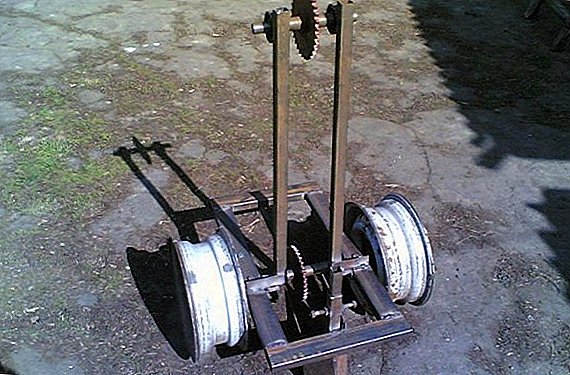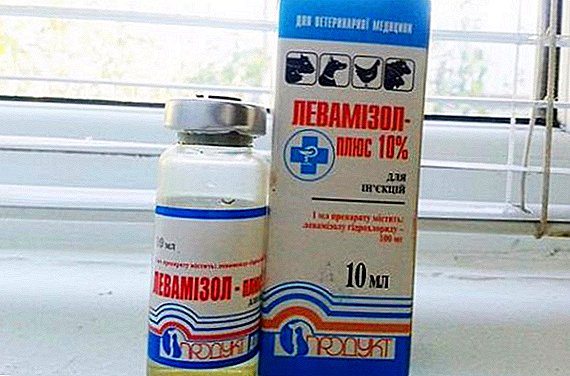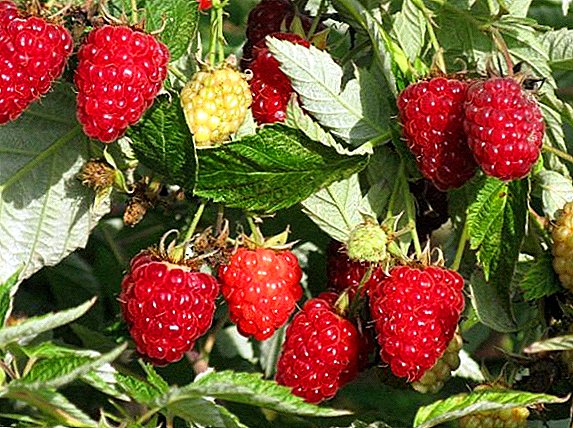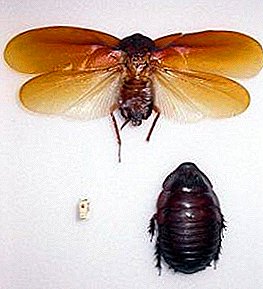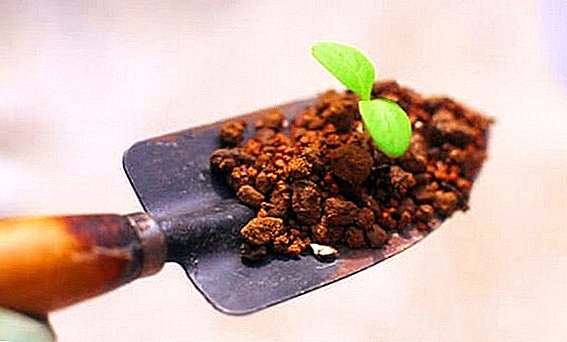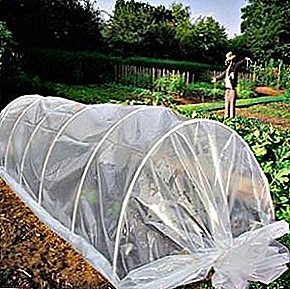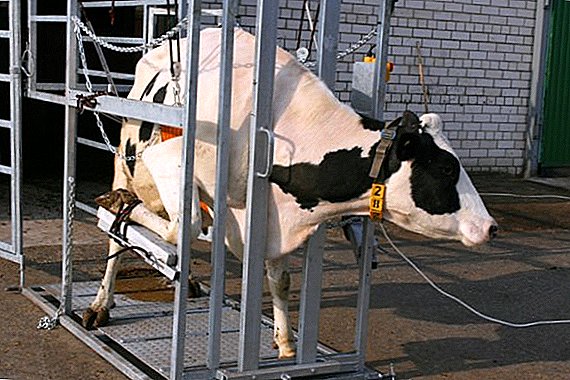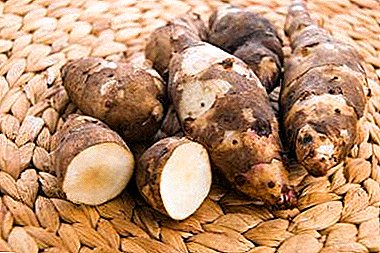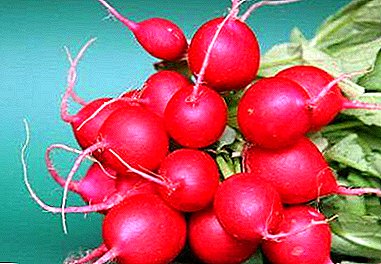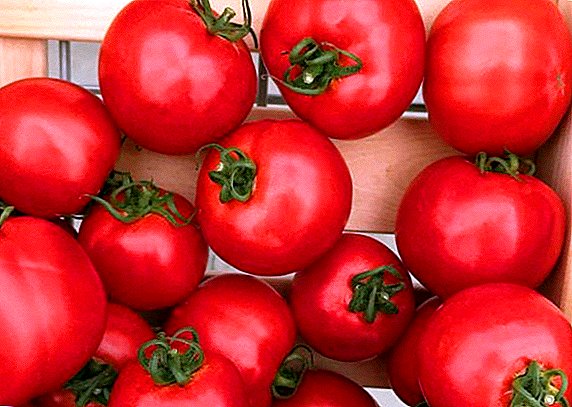 In such a popular and beloved vegetable, like a tomato, now there are many varieties. The most popular in the open spaces of Russia are early and mid-early varieties. For home gardens, the Sultan F1 tomato is a good choice.
In such a popular and beloved vegetable, like a tomato, now there are many varieties. The most popular in the open spaces of Russia are early and mid-early varieties. For home gardens, the Sultan F1 tomato is a good choice.
Let us consider in more detail the features and agrotechnology of growing this hybrid.
Variety description
Tomato "Sultan F1" is a hybrid of the first generation. This is a mid-early and high-yielding variety of Dutch selection, possessing such features:
- deterministic, compact, undersized (50-60 cm tall) bush;
- dark green leaves;
- forms brushes with fruits of 5-6 pieces each;
- extended fruiting period;
- zoned in the following regions: North Caucasus, Lower Volga, Central Chernozem.
Find out what the differences between determinant and indeterminate tomato varieties are.

It has a lot of advantages: great taste with a high content of nutrients and nutrients, great harvest, a long period of fruiting, compactness of the bush, which takes up little space, unpretentiousness and resistance to disease. Only one drawback - like all hybrids, its seeds are not suitable for subsequent sowing.
Did you know? The name of the tomato goes back to their Aztec name "tomato", because these vegetables were imported from America. But their other name "tomatoes" has Italian roots and means "golden apples".
Fruit characteristics and yield
Terms of fruit ripening - 95-110 days from the manifestation of seedlings. With the right agricultural technology, you can get about 15 kg per 1 sq. M. meter This yield is considered high.
Saturated red fruits weighing about 100-200 g, slightly ribbed near the stem, have a juicy pulp of medium density and few seeds. The skin is dense, does not crack, which makes the tomatoes of this variety rather limp and transportable.

The fruits of this variety have a pleasant sweetish taste with a slight sourness. Contain up to 5% solids in juice and up to 2.8% sugar. Perfect for salads and other dishes, suitable for preservation. They make good tomato juice.
Determinant varieties are more compact and require relatively less care, learn about the distinguishing features of the tomatoes "Raspberry Giant", "Star of Siberia", "Klusha", "Chocolate", "Rio Fuego", "Riddle", "Katyusha F1", "Solerosso F1" , Stolypin, Sanka, Apparently Invisible, Lazyka, Torbay F1, Pink Bush F1, Bobkat, Bokele F1, French Grape, Lyana, Prima Donna "," Beginner "," Balcony miracle "," Cio-Cio-San ".
Selection of seedlings
This variety is usually grown in seedlings. When buying seedlings should follow the following rules:
- Choose plants with thick, strong stems and green leaves, well-developed roots, with no signs of damage.
- It should be borne in mind that too saturated color of greens and leaves twisting down are a sign of overfeeding with nitrogen fertilizers for faster growth. Such seedlings should be avoided.
- Selected specimens should not be stained, twisted leaves and other signs of disease and damage by pests. If only one plant is affected, you should still refuse to purchase.
- Seedlings should not be elongated. The optimum height of the bush is no more than 30 cm. Moreover, deterministic varieties on the stem should already have 6-8 leaves.
- Seedlings should be no older than 45-60 days. It is not recommended to buy seedlings with ovaries.
- It is advisable to buy seedlings in containers with nutrient soil - it has the best survival rate, although it is higher price.
- It is best if each bush grows in a separate container, and the plants from the boxes should not be planted too closely. You should avoid plants in bags and with bare roots.

Important! Buying seedlings is sometimes like a lottery, so follows exercise in well-proven, proven people. If this is not possible, then the trader should be asked in detail about the variety and the agrotechnology of cultivation. If the seller has a good knowledge of this information, the probability of a successful purchase is higher. It should not be purchased in different places, as there is a likelihood of any disease of tomatoes.
Soil and fertilizer
Tomato can grow on almost any soil, giving preference to humus-rich sandy or loamy soil with a pH of 5-6. For tomatoes, you should choose the beds, which previously grew gourds, cabbage, cucumbers, roots, peas and other legumes.
It is undesirable to plant tomatoes after other solanaceous (potatoes, eggplants, Physalis), since they have the same diseases and pests. Also on the site should not be stagnant water.
Soil fertility is important for tomatoes, as they take a lot of nutrients from it for their growth and development. During the formation of the root system, the plant especially needs phosphorus, and at the next stage (flowering and fruiting), potassium is actively consumed along with it.
Now, in connection with the rapid growth of food technology, more than ever I want to pamper myself with natural food, in the cultivation of which the "chemicals" were not used. Learn how to use horse, pork, sheep, rabbit dung, banana peel, potato peel, nettle, whey, egg shells, bone meal, tobacco dust, onion peel, charcoal, yeast for plant growth.

These elements are essential for tomatoes for better fruiting and disease resistance. During this period, an insufficient amount of nitrogen can cause a slowdown in the growth of the plant, paleness of the leaves and poor quality of the fruit, and a tendency to disease appears.
If your site is not the most fertile chernozem, you need to prepare it for tomatoes in the fall. It is best to enrich it with organic fertilizers such as rotted manure and compost, add phosphate and potash fertilizers.
From the spring you can add nitrogen supplements. It is recommended to dig up heavy clay soils with coarse sand (8 kg per 1 sq. M), peat (5 kg per 1 sq. M), manure or compost (5 kg per 1 sq. M).
Acidic soils need to lime once every 3-4 years. This is done with lime; charcoal and chalk can also be used. After entering into the soil of these substances it is recommended to dig and carefully water. This procedure is best done in the fall or at least 14 days before planting.
Learn how to independently determine the acidity of the soil in the area, how to deoxidize the soil.
Growing conditions
Tomato should be grown on bright, well-warmed areas of the sun, this vegetable loves heat. Insufficient illumination weakens the plant, retards its growth and ripening fruits. Optimum light day at 12-14 hours.

Seed germination occurs at a temperature of 14-16 ° C, and the best temperature for germination is 20-25 ° C. When the temperature drops to 10 ° C, the growth stops, and when it drops to -1 ° C, the plant usually dies. The ability to normally bloom and bear fruit is lost at temperatures below 15 ° C and above 35 ° C.
Tomatoes are relatively drought tolerant, but to get a good harvest you should water the plants after the top layer has dried. But to the humidity of the air, they are not demanding at all. The best conditions for them are when the air humidity is 45-60% and the humidity of the earth is 65-75%.
Plants must have access to the air - the beds cannot be thickened, it is recommended to loosen the soil.
Growing from seed to seedlings at home
Most reliably grow tomato seedlings on their own. This can be done at home.
Find out when to sow tomatoes for seedlings, how to carry out preplant seed treatment, how to save space and soil when planting seedlings.

Seed preparation
Before sowing, carefully read all the inscriptions on the package. Tomato seeds from many well-known manufacturers no longer need pretreatment.
The bulk material purchased by weight is better treated with a 1% solution of magnesium permanganate. To do this, 1 g of the substance is diluted in 100 ml of water and put the seeds wrapped in gauze in this solution for 20 minutes. Then wash them with water.
3-4 days before planting, it is advisable to soak the seeds of tomatoes for 7-8 hours in the ash solution, mixed in proportion to 1 liter of water 1 tbsp. spoon of ash from the wood. Seeds will swell and absorb the necessary nutrients from such a solution. Then they should be washed, filled up in a bag and placed for three days in a cool place for hardening.
Important! Seeds can be hardened in the refrigerator, but they should be put on the shelf - in no case in the freezer.

Content and location
Best for growing seedlings of tomatoes fit the windows facing south. In case of insufficient lighting it is better to organize lighting. The room's daytime temperature should be around 18-25 ° C, and at night it should be 12-15 ° C. If the air is dry due to the operation of heating systems, it is recommended that the seedlings be sprayed with water from the sprayer 1-2 times daily.
You can grow seedlings in two ways:
- With a pick. In this case, you can initially choose a small shallow container for planting, and then, after germination in a stage of 1-2 leaves, transplant them into containers with a nutrient substrate in which they will be before landing in the ground.
- Without picks. In this case, the seeds are sown immediately in the tank, in which the tomatoes will grow before planting in the ground. You can use cassettes, plastic cups, peat pots and other suitable containers for this. The main thing that they were deep enough (12-17 cm) and wide (12-17 cm) for seedlings, had a drainage hole.
Familiarize with the options of soil disinfection for seedlings, as well as with the subtleties of the picking process.The soil before planting the prepared seeds should be disinfected. To do this, the easiest way to pour it with boiling water or a solution of potassium permanganate.

Seed planting process
The soil in prepared containers should be moistened and compacted. With the method of cultivation with a pick in the box, grooves are made with a depth of 1 cm and between rows of 3-5 cm. Prepared seeds are neatly placed in them at a distance of about 1-2 cm from each other (tweezers can be used).
Then the grooves are sprinkled on top of loose soil and moistened with a spray. From above, the container is covered with a film and placed in a warm place for germination. Some put a heating battery.
It is necessary to control the sufficient moisture content of the seedling tank, open the film and shake off water drops, let the soil breathe for several minutes. With a lack of moisture it is necessary to spray the ground with water, and with an excess - to open the film.
The same is done with the method of growing without picking. Only in each tank do 2-3 holes with a depth of 1 cm and sow one seed in each.
At a temperature of 25-28 ° C shoots may appear in 3-4 days, at 20-25 ° C - already on the 5th day.
Did you know? Tomatoes were introduced in the 16th century to Spain and Portugal, and from there gradually spread across Europe and then around the world. Initially, they were not considered edible and were grown as an exotic plant. The very first recipe for a dish using tomatoes was made public in a cooking book from Naples in 1692 and the author referred to Spanish cuisine.
Video: how to sow tomatoes
Seedling care
As soon as the shoots appeared, the containers are transferred to the lighted place (on the window). We recommend moderate watering and temperature conditions of 15-22 ° C, additional illumination with fluorescent lamps or phytolamps. It is convenient to place the seedling containers on the tray and periodically unfold them 180 ° to the window so that the seedlings stretching towards the light are not one-sided.
On warm days, it is recommended to take out the seedlings on the balcony for hardening, or just to ventilate the room where it grows. Before disembarking, tomatoes should already spend the night on the balcony with the windows open. At the same time, it is also important to provide them with sunny color in open apertures, since the glass retains ultraviolet light.
2-3 after seedlings should begin feeding and make them weekly. It is best to use special organic fertilizers (for example, based on biohumus) or complex mineral fertilizers, soluble in water for this purpose.
Find out when and how to feed tomato seedlings.
 Hardening of tomato seedlings should be gradual, starting from 10-15 minutes a day, otherwise the seedlings can get sunburn
Hardening of tomato seedlings should be gradual, starting from 10-15 minutes a day, otherwise the seedlings can get sunburn
Transplanting seedlings to ground
The seedling is planted in a permanent place in the ground at the age of 45-60 days, when it already has 6-8 leaves.
In the southern regions of Russia, seedlings of middle-early tomato varieties are planted from April 15 to May 1. In the central regions do it from May 1-15. The average air temperature during these periods should not be below 12 ° C. The threat of frost should also be avoided.
But it is safest to plant tomato seedlings when the night temperature is not lower than 15 ° C, and the daytime temperature is about 22-25 ° C. It is best to land on an overcast day or in the evening, so that the plants can get a little comfortable in a new place before the active sun appears.
Seedlings of low-growing varieties of tomato "Sultan" are planted at a distance of 35-40 cm between sprouts and with row-spacings of 50 cm; it should be watered well before disembarking. The holes are made on the bayonet of the spade, watered, and fertilizers are applied (humus, compost, ash). The plant is carefully removed from the tank with a clod of earth, placed in the hole, carefully sprinkled with earth and watered.
Familiarize yourself with the details of planting tomatoes in open ground and in the greenhouse.
Beds with only transplanted seedlings should be covered with film, if necessary, until warm weather is finally established.  Seedlings can be planted earlier, using a greenhouse for these purposes, but in May-June it will need to be transplanted
Seedlings can be planted earlier, using a greenhouse for these purposes, but in May-June it will need to be transplanted
Agricultural technology of growing tomato seeds in the open ground
Cultivation of tomatoes in the open field has its own characteristics.
Outdoor conditions
In the southern regions of Russia, this medium early variety can be grown right in the open field; in other, more northern areas, greenhouse conditions should be used. Usually, in warm regions, the air temperature allows sowing seeds of tomatoes into the ground in the tenth of April - for shelter, and at the end of April-May - in open ground.
Learn how to make a greenhouse yourself, how to choose a covering material for the beds.For the cultivation of tomato on the site should choose a sunny place and prepare the soil, to fertilize. It is appropriate to do such training in the fall. In case of frosts, tender shoots are protected by a cover made of special film or nonwoven materials (for example, lutrasil) that allow air to pass through. You can make caps from scrap materials (plastic, cardboard, roofing felt, etc.). It is best to pull them on the arc.
It is also effective to plant seeds of tomatoes in warm beds, where bio-fertilizers are used, which generate heat when overheated.
Important! Excessive nitrogen in the soil can lead to poor flowering of tomatoes and lower yields. Therefore, it is important to observe the recommended norms when applying fertilizers.

Cultivation of tomatoes in greenhouse conditions differs from planting and maintenance in open soil.
Before planting, it is important to check the greenhouse for tightness and to carry out a complete disinfection, as well as work on disinfection. After carrying out these works for five days you need to ventilate the greenhouse well. As required - completely or partially replace the soil.
The ground flooring itself should not exceed 25 cm, since the ground should warm up. First you need to form the beds. The distance between them should be about 60 cm. They are marked along the length of the greenhouse, but you can also mark it in the form of the letter W or P.
For disembarkation, the wells are made in a staggered manner.
Learn more about growing tomatoes in greenhouses: planting, fertilizing, mulching, pollinating, watering, garter, pinching, diseases.
The process of planting seeds in the ground
After seed treatment, hardening and germination, you can start planting them in open ground.
Usually in the tenth of April the soil is already warm enough and ready for early sowing.
In the prepared soil make holes about 37-40 cm in diameter. Then, they irrigate the land in such wells with a warm solution of manganese. You can sow dry and pre-germinated seeds together, evenly distributing them over the surface of the hole.

This is done as a safety net in case there is a sudden decrease in temperature and, possibly, freezing. In this case, the germinated seeds may die, but the dry ones will not die, but simply germinate later.
When 2-3 true leaves appear, it is necessary to thin out the shoots that have appeared. Промежуток между ними должен быть 6-10 см. Оставлять нужно более сильные ростки.
Повторное прореживание производят при появлении 4-5 настоящих листиков. Перед этим лунку тщательно поливают. В ней оставляют более сильные ростки на расстоянии 13-15 см. When thinning, the shoots are not pulled out, but carefully dug out of the soil. Then they can be planted in another place or moved to a site where there are no shoots or they are very weak.
At the last thinning, 3-4 tomatoes remain with an interval of about 40 cm between them.
Important! As a rule, seed-planted tomatoes are always stronger and less sick than planted seedlings.
Video: the experience of growing seedless tomatoes
Watering
Usually, tomatoes are sprinkled with a sprinkler or drip method. The best is considered drip irrigation. It can be carried out using a conventional plastic bottle, which is dripped neck down near the bushes with tomatoes.
Using a hose in dry weather, watering tomatoes should be carried out under the root. If you water them completely, it will negatively affect flowering, contribute to the falling off of flowers, prevent the formation of the ovary of the fruit and their maturation. Water temperature for irrigation in warm time should not be below 18 ° C. In the cold period, it is better to warm the water for irrigation to 25-30 ° C.
The weather conditions greatly influence the frequency of irrigation.
- In summer, when it is warm, watering is carried out once every two days. Do not allow the topsoil to dry out. In the open ground, this happens faster than in greenhouse conditions.
- In addition, windy weather also contributes to the drying of the soil. With constant wind, watering should be done more often.
- It is especially important to control watering during the formation of the ovary. If it dries out during such a period, it can crumble and the crop will drop sharply.
 Tomato "Sultan", like all tomatoes, prefers moderate watering at the root, excessive moisture is detrimental to the plant
Tomato "Sultan", like all tomatoes, prefers moderate watering at the root, excessive moisture is detrimental to the plant
It should be noted that during the rainy and cold periods, it is necessary to stop watering tomatoes or minimize them. Permanent rain can lead to fungal diseases.
Learn how to water tomatoes in the open field.
Soil loosening and weeding
The land around the bushes should be regularly loosened, while at the same time weeding. The process of loosening allows the root system to breathe; In addition, due to this, the soil better passes moisture.
For the convenience of loosening, you can use the Fokin flat-cutter, which will do an excellent job with this task and at the same time allows you to quickly remove weeds.
Loosening begins immediately after planting the tomatoes. This procedure is carried out at least 1 time in 14 days. Loosening should be about 5-6 cm deep.
It is also necessary simultaneously with weeding and loosening, the hilling of tomatoes is carried out in order to form additional adventitious roots of this culture. It should be noted that this procedure can be carried out if the moisture in the upper layer of the soil will be regularly maintained. Hilling do, the code sprouts grow enough to grow, and then repeat every 14-20 days.

It should be noted that loosening, weeding and hilling is best done after watering. After all, when the earth is wet, these procedures are carried out without additional effort. From wet land and weeds are easier to remove than from dry.
Learn how to get weeds out of the garden.
Masking
Stunted (deterministic) bushes of tomato varieties "Sultan" after tying a certain number of brushes cease to grow. They are formed in 1-3 stalks. Also, when caring for tomatoes, it is important to passchain them. For this purpose, as they grow, all stepchildren must be removed.
In the twentieth of August, it is necessary to make a spike of the tops of this culture, and also to remove all the flowers and small fruits that have not reached the size of a hazelnut. But a few bushes can be left - in case the beginning of autumn will be warm. If the summer was cool and rainy, some of the brushes should also be removed to speed up the ripening of the remaining fruits.
In the southern regions with a warm summer, a variety of tomatoes "Sultan" you can not stepchild at all.

Leaves at the bottom of the bush, as well as yellowed leaves are recommended to cut off. This is done for faster ripening of tomatoes, as well as to grow larger fruits. To accelerate the ripening of tomatoes can and the process of pinching the tips of the shoots that bear fruit.
Garter
Low-growing varieties of tomatoes do not always need a garter. But sometimes the bushes of tomatoes overloaded with fruits start to lean to the ground and can break. In addition, the fruits in contact with the soil, begin to rot and deteriorate. It should also be borne in mind that irrigation of this crop should be carried out at the root, and if a tomato lies on the ground, then the implementation of such irrigation becomes problematic.
The garter is carried out in different ways:
- To the peg, which is driven in close. The easiest way that gardeners love to use. With this method of brush with large fruits gently fixed to the support with a rope or a fabric tape. You can not use for this wire or fishing line, so as not to squeeze the stem.
- With trellis, located at a certain distance from each other. Between them, horizontally stretch the wire, leaving 45 cm between the rows of the wire — brushes and stalks of tomatoes are tied to it.
Check out the guidelines for gartering tomatoes in the open field.
In addition, the fruits that lie under their weight on the ground, you can gently put on the planks, twigs, mowed grass.
 Tomato "Sultan" can be grown without garters
Tomato "Sultan" can be grown without garters
Top dressing
To strengthen the tomatoes and increase yields as they grow, make feeding. Organic fertilizers - cow dung or chicken litter are excellent for this.
Cow manure is mixed with water in a ratio of 1 to 10, and chicken manure - 1 to 15. The resulting solution is used in a volume of 1 liter per tomato bush. Top dressing do after watering.
At the beginning of fruiting, it is recommended to fertilize with wood ash and loosen the soil, since this crop does not like acidic soils.
Pests, diseases and prevention
Tomatoes can be susceptible to many diseases and pests. Timely identification of them and the adoption of appropriate measures is the key to a good future harvest.
Consider the most common ones:
- Vertex rot of fruit. The tops of more green fruits get brownish or almost black color. It occurs when calcium is deficient, and may also be the result of a conflict situation arising from the interaction of potassium and calcium, when one element interferes with the flow of another. To eliminate this problem, as well as for prevention, you need to add 1 tbsp to the soil when planting. spoon of calcium nitrate and wood ash.
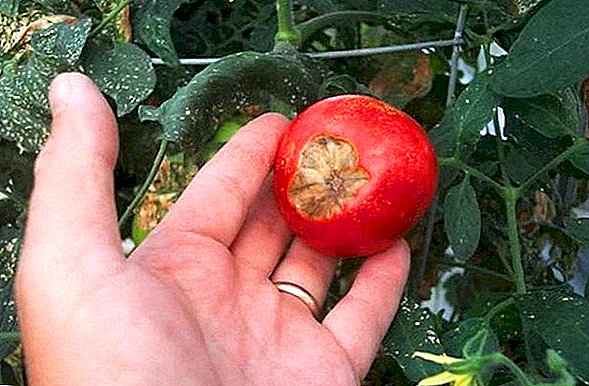
- Alternaria. Manifested in the form of brownish spots with temperature drops in the spring or at the end of the summer season. The disease can perezimovat on plant debris or transmitted through seeds. It affects the entire above-ground part of the tomato bush, including the still green fruit. When the first signs of infection are found, the bushes should be treated with “Skor”, “Ridomil Gold” or other means against fungal infections.

- Fusarium wilting tomatoes - this is a fungal disease. The infection infects the root system, and the tomatoes look as if they lack moisture. The bush withers, the leaves below begin to acquire a yellow color, the stem darkens and cracks appear on it. To treat this trouble, you can use the drugs "Trikhodermin" or "Previkur."
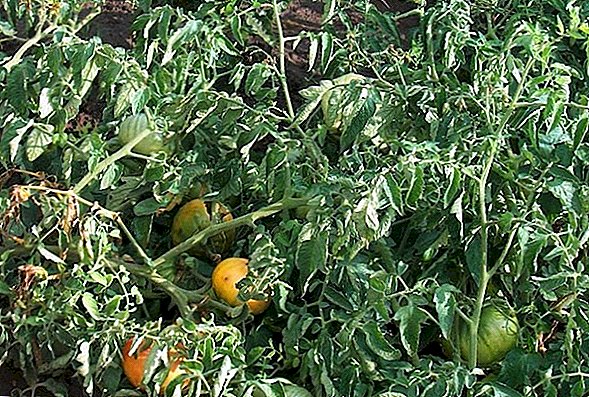
- Gray rot - It is also a fungal disease. It affects tomatoes in cool weather with frequent rains. Manifested in the form of dark spots that affect the upper part of the plant (stem, leaves, fruits). As soon as the rains come to an end and the sun's rays warm up the earth well, this trouble passes. If tomatoes are affected by this disease, Euparine or Bayleton will help fight it.
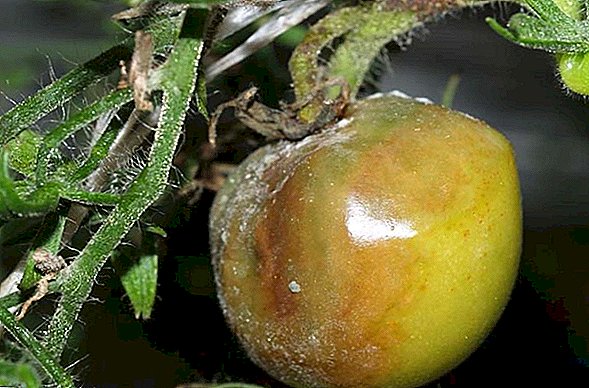
- Late blight - the most unpleasant disease for tomatoes. With the defeat of them on the plants appear dark spots, the leaves become yellow and wither, the fruits begin to deteriorate. The causative agent of this disease is in the soil, is carried by the wind, can get on the garden bed with water. This disease is favored by increased moisture content in the air. Therefore, a measure of prevention is drip watering or watering at the root. You can not plant tomatoes with potatoes, they will infect each other with this disease. As prophylactic agents, Pentafag and Mikosan are well suited, and for the control of an already beginning disease, the chemical preparations Infinito, Tattu, Ridomil Gold, Quadris and Bordeaux liquid.
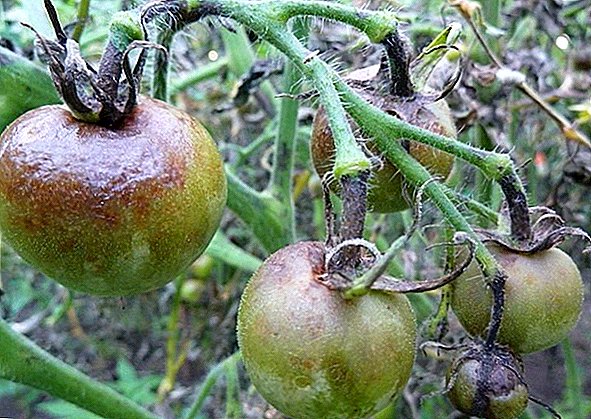
- Leaf Twisting Virus. Often occurs due to lack of moisture or copper. Basically the virus is transmitted through the seeds. Therefore, it is important to carry out seed disinfection before planting. It is better to remove the tomatoes affected by this disease. For prevention, you need to ensure that the tomatoes are not dry, and in a timely manner to make feeding.
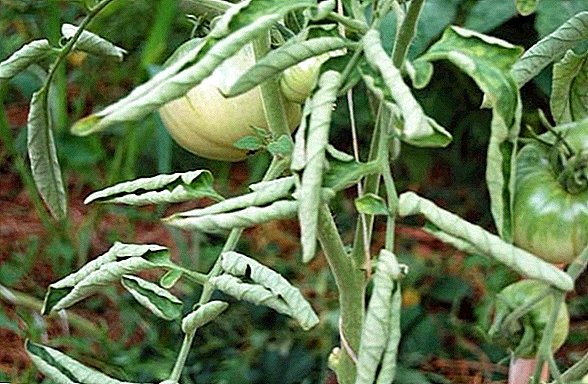
- Aphid. A common problem with tomatoes. Well helps the treatment of leaves with ashes. Leaves can also be wiped with a decoction of yarrow, chamomile or tobacco. Against aphids, there are many chemical products and biologics (for example, Verticillin).

- Spider mite - a natural pest, due to which the leaves are covered with small whitish specks. The size of the tick is less than 1 mm and it is difficult to consider it with the naked eye. The "Aktophyt" biological product will perfectly cope with such a pest. Often, these insects are parasitic in greenhouses or in beds when tomatoes are covered with frost film. Therefore, to combat them recommend to remove the film from the greenhouse or tomatoes.

- White fly. It is a small white midge that is a pest for this crop. To get rid of them in the greenhouse, you need to constantly carry out ventilation, use adhesive tapes as bait. You can also use the drug "Bowerin."
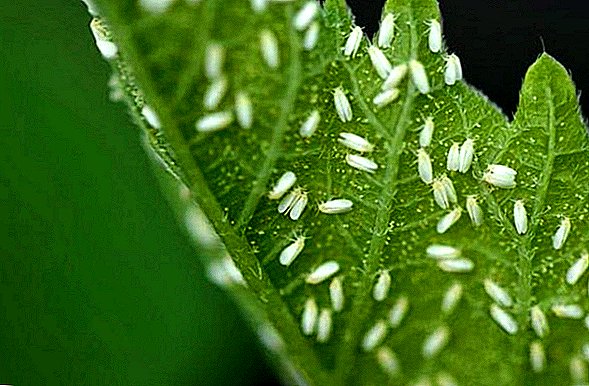
Learn more about pests and diseases of tomatoes.For general prophylaxis against many diseases, the following treatments are recommended:
- When the fruits begin to grow, tomatoes are recommended to spray the drug "Tomato Saver". It protects against late blight, macrosporosis, and is also a growth stimulant. As a spraying, you can use a one-percent solution of Bordeaux mixture or a solution of copper sulfate in the proportion of 40-50 g per 10 liters of water. It is advisable to make a couple of such treatments.
- Excellent help from diseases and pests such a natural remedy, as the infusion of garlic. For its preparation, about two glasses of garlic are crushed and filled with hot water (boiling water should not be used). Then topped up to 10 liters, and then - mixed and filtered. You can add a little potassium permanganate. This solution does not need to be infused, it is used immediately after preparation. Such treatments are carried out every 7-10 days.
- To this solution is well stuck to the leaves, you can add a liquid laundry soap. This treatment is carried out as needed - usually 3-4 times.

Harvesting and storage
It is necessary to regularly pluck ripened and reddened tomatoes. With every 1 square. meters of planted tomatoes "Sultan" you can get about 15 kg yield.
Ripening of the main part of the tomatoes begins in July and lasts until the second half of August. Toward the end of August, the bushes and leaves gradually begin to die off. It is during this period that the resistance of plants to many diseases decreases. Therefore, it is recommended that ripe fruits be removed before the beginning of August, and with them those that have begun to ripen.
With a possible cold snap up to 5 ° C or forecasting rainfall at a temperature of 8 ° C, all fruits, including green ones, must be collected, otherwise they will disappear. Then on the site you need to remove all the bushes. If such a decrease in temperature is not predicted, then the crop ripens in a timely manner, and the crop dies off in the last days of August.
When the leaves die, they turn yellow and become covered with specks, but this process does not affect the quality of the tomato fruit. That is why, if there is no frost, poured green fruit can be left to ripen on the bushes until the end of August.

For red fresh tomatoes, the recommended shelf life is no more than 5 days. They are used for quick use in the preparation of salads, appetizers, juice and other things. Unripe tomatoes have a shelf life of more than 10 days, and green ones have even more.
Learn how to store tomatoes.
For longer storage tomatoes canned, salted, pickled, squeezed tomato juice.
Due to its thick skin and medium size tomato variety "Sultan" is well suited for storage. To do this, tomatoes need to sort out. Rotten and wrinkled should be put aside, and more solid, without dents, - carefully lay in wooden boxes. It is better to cover the bottom with straw, and cover the top with a lid - so as not to crush the tomatoes. They are then placed in a cool, well-ventilated room and stored for about two months.
Later, planted bushes can give a harvest later. The fruits will not be so red, but of milk maturity. Keep them longer.
In winter, you want a varied summer menu; you can add bright accents to the blanks, so many housewives know how to cook adjika, tomato juice, salted, pickled tomatoes, salads, tomatoes in jelly.
Possible problems and recommendations
When growing tomatoes can be faced with various problems. For example, tomatoes ugly and gnarled. This is due to temperature changes.
The appearance of dark brown, hard-to-touch spots on tomatoes is usually caused by a lack of boron. In this case, it is necessary to feed with boric acid in the proportion of 5 g per 10 liters of liquid.

If the fruit grow hollow, it means that pollination has passed badly. This process is adversely affected by heat (above 35 ° C) or, conversely, too low (less than 10 ° C) ambient temperature. Excessive moisture contributes to the formation of voids. To avoid this problem, experts recommend several times a week to gently shake the plants in the morning to improve the pollination process and the formation of the ovary. If the cultivation takes place in a greenhouse, it must be regularly ventilated.
If the tomatoes are small in size, this is most likely due to poor flower development, poor pollination, low viability, lack of sunlight, overheating from heat, and excess nitrogen.
Negatively, low air humidity (less than 50%) affects the formation of the ovary and the growth of tomato fruits.
The lack of minerals is completely determined by the appearance of the plant:
- Lack of nitrogen makes the bushes pale green and weakens;
- an insufficient amount of phosphorus stains the leaves in red-violet tones, inhibits growth and fruiting;
- a small amount of potassium is expressed in a bronze border on the leaves;
- on acidic soil with a lack of calcium, the tops and other growth points begin to die off and turn black; poor fruiting is noted.
Video: visual signs of nutritional deficiencies
The variety of tomatoes "Sultan F1" is perfect for gardens in country houses and private plots, as it is an unpretentious medium-early variety with excellent taste. He has a prolonged period of fruiting, which is important for owners of small plots. His seedlings can be bought, and you can grow yourself even at home. Correct and simple agricultural technology will provide you with a good harvest.
Reviews of Tomato "Sultan F1"













